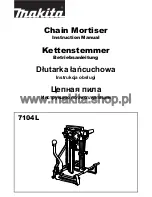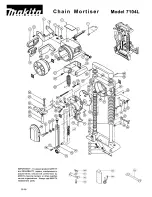
3 ENGLISH
18.
Use outdoor extension leads.
When tool is used outdoors, use only extension
cords intended for outdoor use.
19.
Stay alert.
Watch what you are doing. Use common sense.
Do not operate tool when you are tired.
20.
Check damaged parts.
Before further use of the tool, a guard or other part
that is damaged should be carefully checked to
determine that it will operate properly and perform
its intended function. Check for alignment of mov
-
ing parts, free running of moving parts, breakage
of parts, mounting and any other conditions that
may affect its operation. A guard or other part
that is damaged should be properly repaired or
replaced by an authorized service center unless
otherwise indicated in this instruction manual.
Have defective switches replaced by an autho
-
rized service facility. Do not use the tool if the
switch does not turn it on and off.
21.
Warning.
The use of any accessory or attachment, other
than those recommended in this instruction man
-
ual or the catalog, may present a risk of personal
injury.
22.
Have your tool repaired by a qualified person.
This electric tool is in accordance with the relevant
safety requirements. Repairs should only be car
-
ried out by qualified persons using original spare
parts, otherwise this may result in considerable
danger to the user.
ADDITIONAL SAFETY RULES FOR
TOOL
1.
Wear hearing protection.
2.
Keep Guards In Place and In Working Order.
Never wedge or tie lower guard open. Check
operation of lower guard before each use.
Don’t use if lower guard does not close briskly
over saw blade.
CAUTION: If saw is dropped, lower guard may
be bent, restricting full return.
3.
Do not use blades which are deformed or
cracked.
4.
Do not use blades made of high speed steel.
5.
Do not stop the blades by lateral pressure on
the saw blade.
6.
Keep Blades Clean and Sharp. Sharp blades
minimize stalling and kickback.
7.
DANGER:
Keep Hands Away From Cutting Area.
Keep hands away from blades. Don’t reach
underneath work while blade is rotating. Don’t
attempt to remove cut material when blade is
moving.
CAUTION: Blades coast after turn off.
8.
Support Large Panels (Fig. 1 & 2).
Large panels must be supported as shown in
Fig. 1 to minimize the risk of blade pinching
and kickback.
When cutting operation requires the resting
of the saw on the workpiece, the saw shall be
rested on the larger portion and the smaller
piece cut off.
Fig. 1
To avoid kickback, do support board or panel near the cut.
Fig. 2
Do not support board or panel away from the cut.
9.
Use Rip Fence.
Always use a fence or straight edge guide
when ripping.
10.
Guard Against Kickback. (Fig. 1 & 3)
Kickback occurs when the saw stalls rapidly
and is driven back towards the operator.
Release switch immediately if blade binds or
saw stalls.
Keep blades sharp. Support large panels as
shown in Fig. 1.
Use fence or straight edge guide when ripping.
Don’t force tool. Stay alert-exercise control.
Don’t remove saw from work during a cut while
the blade is moving.
NEVER place your hand or fingers behind the
saw. If kickback occurs, the saw could easily
jump backwards over your hand, possibly
causing severe injury.


























